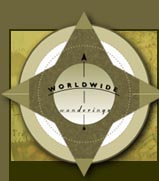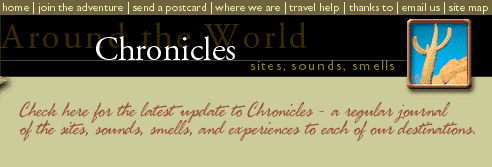|
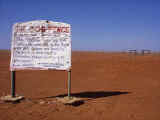 June 11-14, 1999
South Australia Outback, Australia June 11-14, 1999
South Australia Outback, AustraliaTo the east: mountains.
To the west: nothing. Nothing for as far as the eye can see or the mind can imagine. Only
miles and miles of cinnamon colored sand. Sand sprinkled with gray saltbush, stoney
gibber, maybe some spiky spnifex grass, all tossed within a sparse scattering of scraggly
black trees. A long, straight line of ebon ribbon lays down before us, cutting
persistently through the flat, sparse, and arid expanse of the south Australian plain.
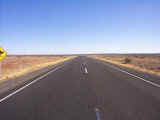 "Look at that" I whisper,
tapping Laura on the shoulder and pointing out the van's windshield. Down the road
about 200 yards, I'd swear that the only water for miles has gathered itself into
shimmering silver puddles, flooding the length of asphalt in front of us that used to be a
highway. But the closer we try to get to the 'water', the faster it just 'evaporates'
before our eyes, each 'puddle' vanishing consecutively as we approach it. "Look at that" I whisper,
tapping Laura on the shoulder and pointing out the van's windshield. Down the road
about 200 yards, I'd swear that the only water for miles has gathered itself into
shimmering silver puddles, flooding the length of asphalt in front of us that used to be a
highway. But the closer we try to get to the 'water', the faster it just 'evaporates'
before our eyes, each 'puddle' vanishing consecutively as we approach it.
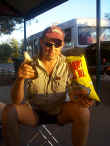 Welcome to the land of mirages, I think to myself,
welcome to the South Australia Outback, welcome to the place where almost nothing's just
the way it seems. As night falls, Steve (our guide and driver) does his best to get us
ready for our coming adventure, easing us into our new environment with a few pounds of
kangaroo on the 'barbie' and a slew of campfire stories. And it works, we sleep like
little joeys. Welcome to the land of mirages, I think to myself,
welcome to the South Australia Outback, welcome to the place where almost nothing's just
the way it seems. As night falls, Steve (our guide and driver) does his best to get us
ready for our coming adventure, easing us into our new environment with a few pounds of
kangaroo on the 'barbie' and a slew of campfire stories. And it works, we sleep like
little joeys.
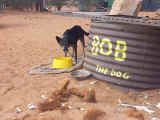 It's
the beginning of day two. We're only on paved road for a short time this morning, before
our small bus turns off the highway and onto the dirt and gravel road known as the
Oodnadatta Track. We follow the famous old Ghan Railway (at one time the only consistent
link between the north and south of this enormous country) for hours and hours. It's
the beginning of day two. We're only on paved road for a short time this morning, before
our small bus turns off the highway and onto the dirt and gravel road known as the
Oodnadatta Track. We follow the famous old Ghan Railway (at one time the only consistent
link between the north and south of this enormous country) for hours and hours.
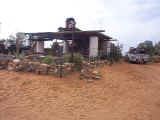 This stretch does well to prove that the Aussie Outback is, if
nothing else, big country, harsh country. A plume of dust rises up from far in the
distance - it signifies a rare sight, that of another vehicle coming our way on this
normally empty and desolate length of road. They're most likely coming from one of this
area's few towns, and our destination for the night, the 'sprawling metropolis' of William
Creek, South Australia. This stretch does well to prove that the Aussie Outback is, if
nothing else, big country, harsh country. A plume of dust rises up from far in the
distance - it signifies a rare sight, that of another vehicle coming our way on this
normally empty and desolate length of road. They're most likely coming from one of this
area's few towns, and our destination for the night, the 'sprawling metropolis' of William
Creek, South Australia.
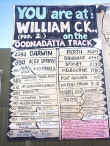 William
Creek William
Creek
'It ain't pretty, but I guess it works' I think to myself as I read the numbers,
scribbled in black across a framed newspaper article (the only one written about the
'town', about ten years ago). "4+2+6+1+7+6=13-2=11+1=12-2=10" and so on. No,
it's not the scribblings of a child struggling with a math problem, it's the William Creek
census, a careful record of the rises and falls, ups and downs, of the hamlet's population
over the past few years. And it's prominently posted here, in the largest (and by far the
most important) of the town's five structures - The William Creek Hotel (hotel is Aussie
for Pub). Officially, William Creek has a population of 2 (the publican and his wife).
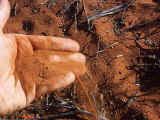 But stretching things to 'Greater William Creek' pumps the total up
to 12 or so. And while it seems that every town, large or small, tries to stake its claim
to something or other in search of an identity, William Creek does the same with its
'Gateway to the desert' tag. Gateway or no-way, I'm not sure. But here it sits, on the
edge of the driest, hottest, part of one of the most desolate areas in the world, Stuart
Desert. In this part of the world they measure rainfall in drops, not inches. And they
gauge heat (up to 136 in the shade) with a 'faint factor', not with degrees. But stretching things to 'Greater William Creek' pumps the total up
to 12 or so. And while it seems that every town, large or small, tries to stake its claim
to something or other in search of an identity, William Creek does the same with its
'Gateway to the desert' tag. Gateway or no-way, I'm not sure. But here it sits, on the
edge of the driest, hottest, part of one of the most desolate areas in the world, Stuart
Desert. In this part of the world they measure rainfall in drops, not inches. And they
gauge heat (up to 136 in the shade) with a 'faint factor', not with degrees.
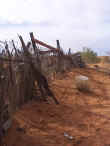 The actual 'town' itself is actually a meandering set of sheds, all
completed and tacked to one another over the last century or so. Very purposely built low
and sturdy enough as to not to be whipped into pieces by the gusting dessert wind. Here I
stand in the hotel, center of it all, with Victoria Bitter in hand, admiring the
'wallpaper' of countless business cards, ID's of all sort, colorful currency notes, even
police summons; tacked up by those before us, travelers from all around the planet. Laura
borrows a staple gun, and with a quick 'pop', www.worldwidewanderings.com joins the
hundreds and hundreds of others immortalized on these dusty walls. This place is truly
amazing - the ceiling's adorned with t-shirts, women's undergarments, even a 18 inch long
decomposing rat corpse that "a camper was a bit surprised to find in his sleeping bag
a few months back". The actual 'town' itself is actually a meandering set of sheds, all
completed and tacked to one another over the last century or so. Very purposely built low
and sturdy enough as to not to be whipped into pieces by the gusting dessert wind. Here I
stand in the hotel, center of it all, with Victoria Bitter in hand, admiring the
'wallpaper' of countless business cards, ID's of all sort, colorful currency notes, even
police summons; tacked up by those before us, travelers from all around the planet. Laura
borrows a staple gun, and with a quick 'pop', www.worldwidewanderings.com joins the
hundreds and hundreds of others immortalized on these dusty walls. This place is truly
amazing - the ceiling's adorned with t-shirts, women's undergarments, even a 18 inch long
decomposing rat corpse that "a camper was a bit surprised to find in his sleeping bag
a few months back".
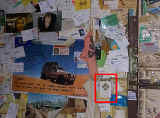 Yep, the wildlife tales are all just a part of the
legends. Up until a few years ago, the pub even had a resident mule. Unfortunately, it
seems that he followed the other patrons examples, developing a liking for beer. He even
learned how to pick up a can with his teeth and chug it down. Well, the story has it that
he got a bit jealous one night when another patron (of the male inclination) unknowingly
interrupted an ear scratching session he was getting from one of the other guests (of the
female inclination). The mule kicked him into a wall and neither have been invited back
ever since. Yep, the wildlife tales are all just a part of the
legends. Up until a few years ago, the pub even had a resident mule. Unfortunately, it
seems that he followed the other patrons examples, developing a liking for beer. He even
learned how to pick up a can with his teeth and chug it down. Well, the story has it that
he got a bit jealous one night when another patron (of the male inclination) unknowingly
interrupted an ear scratching session he was getting from one of the other guests (of the
female inclination). The mule kicked him into a wall and neither have been invited back
ever since.
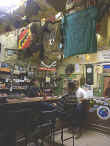 Animal stories aside, the pub is a
curious, but comfortable place with it's own way of doing things. For instance, there's
the sign behind the bar that reads "Y.C.A.T.S.W.C.Y. A.D.F.R.F.D." It turns out
to be a sure fire method of collecting money from inquiring types like me, who are
required to but a dollar in the bra hanging from the ceiling above (50c in each cup), to
find out that "your curiosity about this sign will
cost you a dollar for Royal Flying Doctors".
Oh well, it's a good cause, emergency medical care or evacuation by air for those who
choose to make their lives out here in the middle of nowhere. Animal stories aside, the pub is a
curious, but comfortable place with it's own way of doing things. For instance, there's
the sign behind the bar that reads "Y.C.A.T.S.W.C.Y. A.D.F.R.F.D." It turns out
to be a sure fire method of collecting money from inquiring types like me, who are
required to but a dollar in the bra hanging from the ceiling above (50c in each cup), to
find out that "your curiosity about this sign will
cost you a dollar for Royal Flying Doctors".
Oh well, it's a good cause, emergency medical care or evacuation by air for those who
choose to make their lives out here in the middle of nowhere.
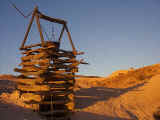 Coober Pedy Coober Pedy
Our next stop is yet another desert town priding itself for being out in the middle
of nowhere - the hamlet of Coober Pedy. The town derives its name from the Aboriginal
phrase 'kupa piti', which loosely translated, means 'white man's hole in the ground'. It
seems that of the town's 4,500 residents, 80% live underground. Yes, underground.
Considering how hot it gets out here, or what most of these folks do for a living, that
statistic isn't all that unusual. Our group just learned that Coober Pedy is the largest
producer of opals in the world. And considering that these beautiful, rainbow colored,
'fire in the sand' stones have to be mined out of the ground, I suppose living underground
makes more than just a little sense.
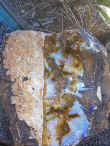 Seems
that the residents here have figured out that they can kill two birds with one 'stone', so
to speak. In Coober Pedy, building (or more accurately digging) a new house can be a
rewarding proposition. Even the normally loathsome task of home improvement can turn out
to be a profitable undertaking. Of local legend is the housewife who had been pestering
her husband to add an adjoining pantry to their subterranean kitchen for a number of
years. Finally getting frustrated, she took matters into her own hands, grabbed her
husband's best pick, and began wailing away at the limestone herself. Her husband's first
reaction was astonishment and anger. That reaction was short-lived however, as the couple
ended up uncovering $180,000 worth of opals. After adding 10 more bedrooms, the couple is
now worth millions. Seems
that the residents here have figured out that they can kill two birds with one 'stone', so
to speak. In Coober Pedy, building (or more accurately digging) a new house can be a
rewarding proposition. Even the normally loathsome task of home improvement can turn out
to be a profitable undertaking. Of local legend is the housewife who had been pestering
her husband to add an adjoining pantry to their subterranean kitchen for a number of
years. Finally getting frustrated, she took matters into her own hands, grabbed her
husband's best pick, and began wailing away at the limestone herself. Her husband's first
reaction was astonishment and anger. That reaction was short-lived however, as the couple
ended up uncovering $180,000 worth of opals. After adding 10 more bedrooms, the couple is
now worth millions.
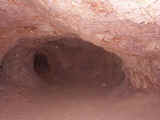 Along
with digging a guest bedroom, there are many other methods for uncovering the earth's
hidden riches of opals. One of the more popular (and also least expensive) is called
'noodling', or sifting through the hundreds of piles of waste dirt left aside the shaft
mines. One of the ladies we're chatting with, tells us of the morning she "really hit
it", uncovering $11,000 worth of the gems before breakfast. "Before lunch I was
headed for the closest big city to here (that'd be Adelaide ya know), to go have myself a
little fun. Boy, I reakon those were the best four days of my life. But after only four
days, my pockets were empty, so I came back here try again." And such is the
prevailing attitude around C.P. - easy come, easy go. Along
with digging a guest bedroom, there are many other methods for uncovering the earth's
hidden riches of opals. One of the more popular (and also least expensive) is called
'noodling', or sifting through the hundreds of piles of waste dirt left aside the shaft
mines. One of the ladies we're chatting with, tells us of the morning she "really hit
it", uncovering $11,000 worth of the gems before breakfast. "Before lunch I was
headed for the closest big city to here (that'd be Adelaide ya know), to go have myself a
little fun. Boy, I reakon those were the best four days of my life. But after only four
days, my pockets were empty, so I came back here try again." And such is the
prevailing attitude around C.P. - easy come, easy go.
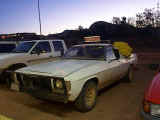 Yep, it's the prospect of a quick fortune that lures
most folks to Coober Pedy. And it's the mix of from-all-walks-of-life, modern-day-pioneers
that gives this area its untamed feel, and it's own code of justice. A code whose main
deterrent is being on the receiving end of a stick of dynamite. It seems that when someone
has a beef in this town, they're more likely to 'blow your top' than theirs - literally.
Take the story from just a few months ago, of the last Coober Pedy Times newspaper
building being blown to the high heavens late one night. The reputed reasoning? Repeated
inaccurate TV listings (no one was injured). Yep, it's the prospect of a quick fortune that lures
most folks to Coober Pedy. And it's the mix of from-all-walks-of-life, modern-day-pioneers
that gives this area its untamed feel, and it's own code of justice. A code whose main
deterrent is being on the receiving end of a stick of dynamite. It seems that when someone
has a beef in this town, they're more likely to 'blow your top' than theirs - literally.
Take the story from just a few months ago, of the last Coober Pedy Times newspaper
building being blown to the high heavens late one night. The reputed reasoning? Repeated
inaccurate TV listings (no one was injured).
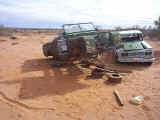 Then there's the tale, from a few years
back, of the two policemen - new in town and intent on slapping the local's vehicles
with 'unfit' stickers and associated fines. Well, after a day or two of this, the
residents decided to let them know how they felt about being bothered with their 'city
rules', and simply blew up their patrol car under protest (again, no one was hurt). Then there's the tale, from a few years
back, of the two policemen - new in town and intent on slapping the local's vehicles
with 'unfit' stickers and associated fines. Well, after a day or two of this, the
residents decided to let them know how they felt about being bothered with their 'city
rules', and simply blew up their patrol car under protest (again, no one was hurt).
Well tonight, as Laura and I bed down in the bed rock (yes, we're sleeping
underground too, kinda like Fred and Wilma Flintstone), and these colorful stories help me
drift off to sleep, I can't help but think to myself 'welcome to the land of mirages,
welcome to the South Australia Outback, welcome to the place where almost nothing's just
the way it seems.
|
